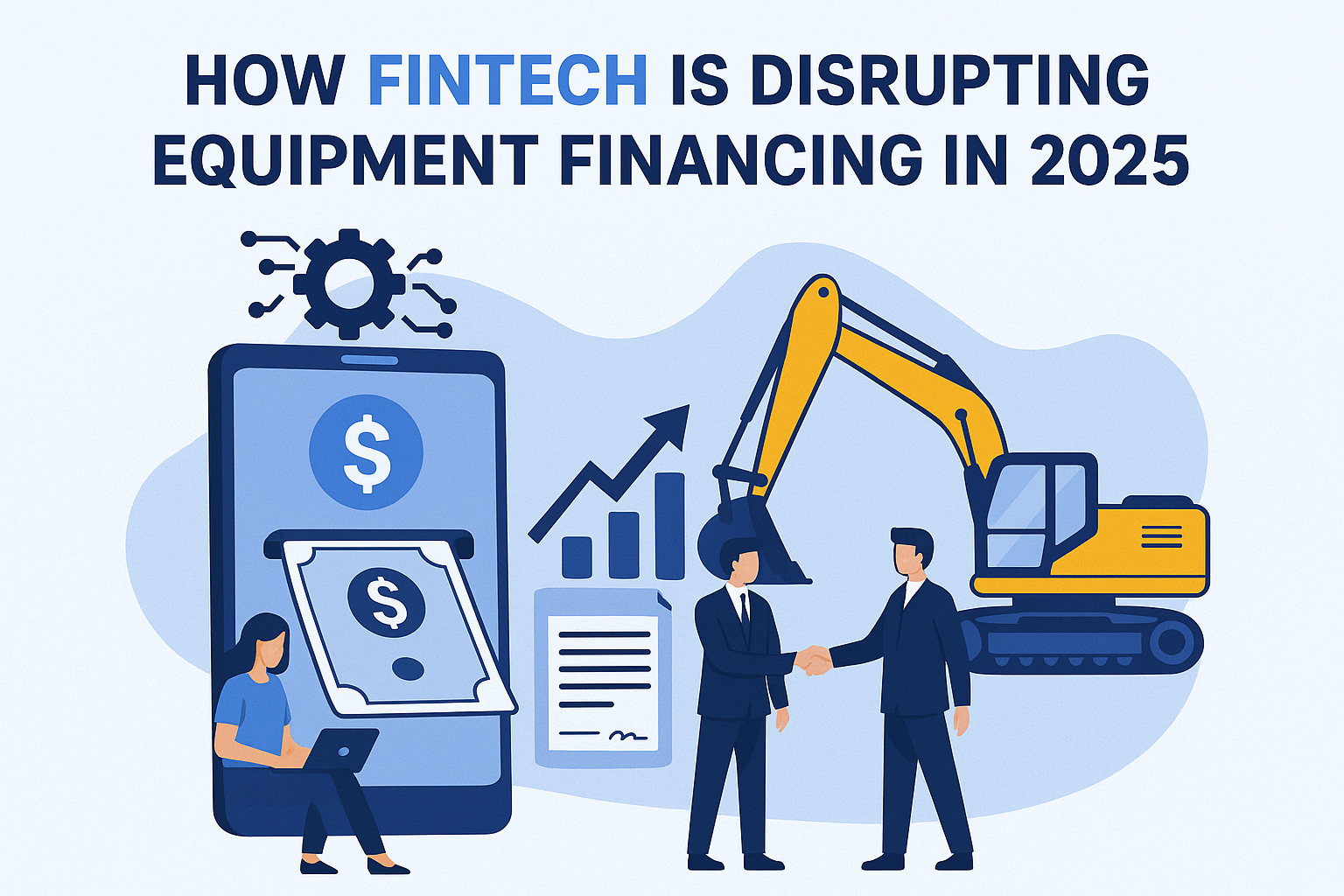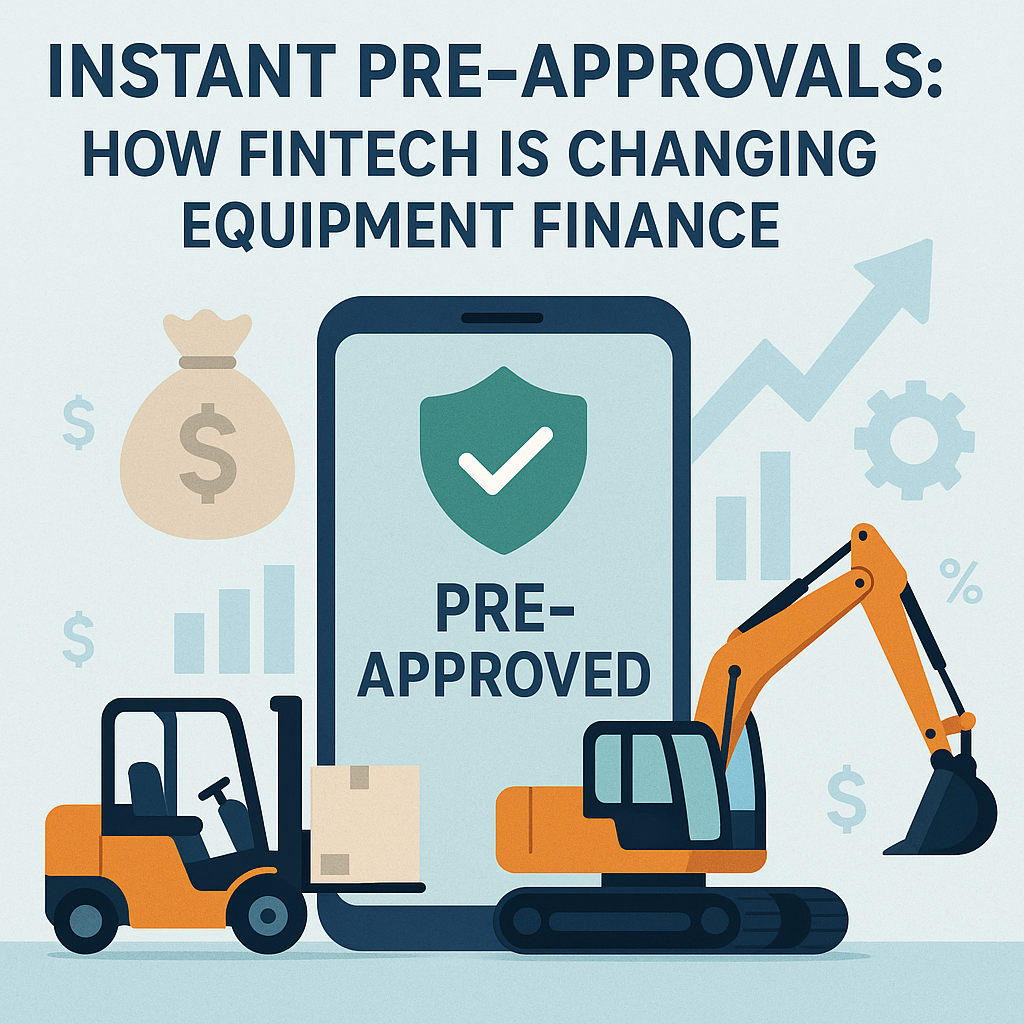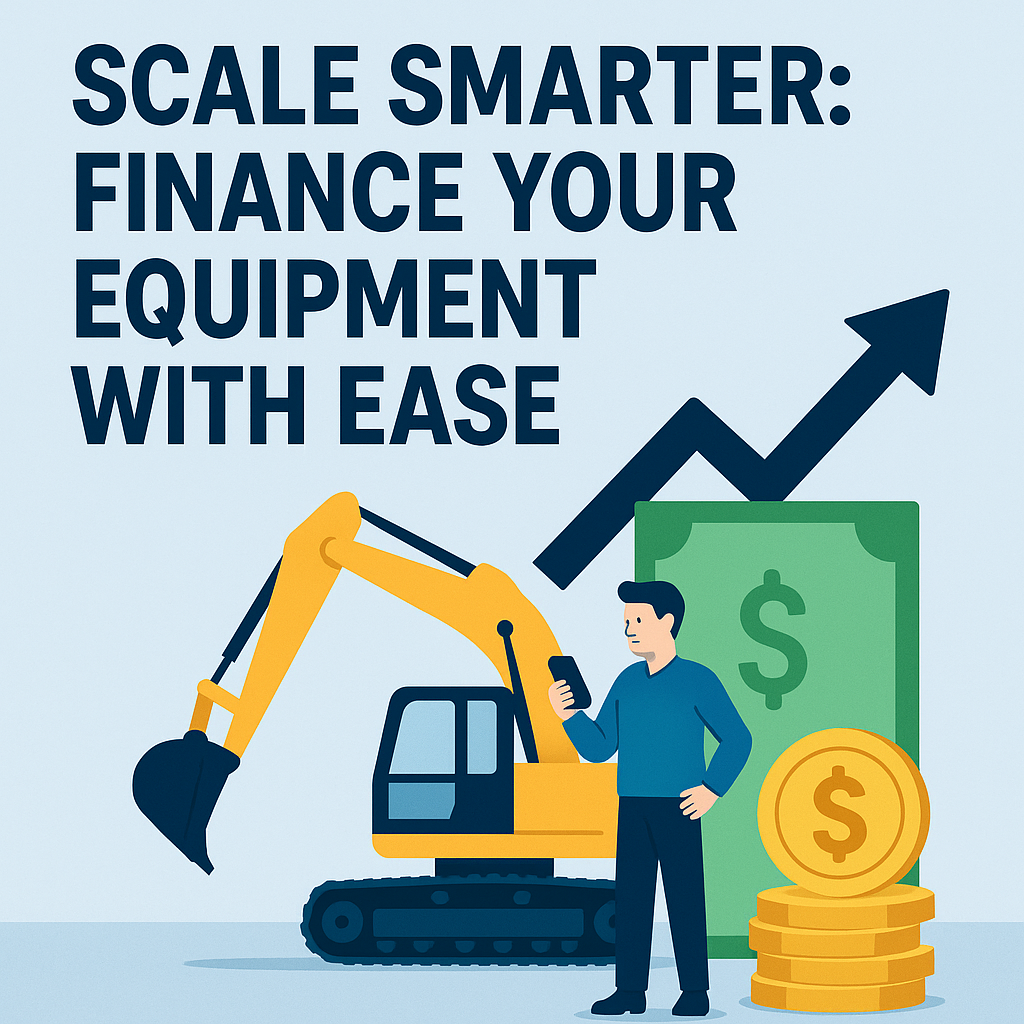How Fintech Is Disrupting Equipment Financing in 2025

The equipment financing landscape is undergoing a radical transformation. Traditional lending institutions that once dominated this $1.2 trillion market are now competing with innovative fintech companies that are rewriting the rules of business equipment loans. From artificial intelligence-powered credit decisions to blockchain-secured transactions, the way businesses acquire essential equipment has never been more dynamic or accessible.
The Traditional Equipment Financing Landscape
For decades, equipment financing followed a predictable pattern. Banks and specialized lenders required extensive paperwork, lengthy approval processes, and rigid qualification criteria. Small businesses often waited weeks or months for funding decisions, creating cash flow challenges and missed opportunities.
The old system relied heavily on credit scores, lengthy financial statements, and collateral requirements that excluded many growing businesses. This approach, while conservative, left significant gaps in the market that fintech innovators are now filling with remarkable success.
Key Fintech Innovations Transforming Equipment Financing
Artificial Intelligence and Machine Learning
Modern fintech platforms leverage sophisticated algorithms to assess creditworthiness in minutes rather than weeks. These systems analyze hundreds of data points, including real-time business performance metrics, payment histories, and industry-specific factors that traditional lenders often overlook.
Machine learning models continuously improve their accuracy by processing vast amounts of transaction data, enabling more precise risk assessment and competitive interest rates for qualified borrowers.
Alternative Data Sources
Today’s fintech lenders examine unconventional data streams to build comprehensive borrower profiles. Bank transaction patterns, social media presence, supplier relationships, and even utility payment histories contribute to credit decisions. This approach opens financing opportunities for businesses with limited traditional credit history.
Embedded Finance Solutions
Equipment manufacturers and dealers now integrate financing options directly into their sales processes. When a contractor needs a new excavator or a restaurant requires commercial kitchen equipment, financing can be arranged and approved within the same digital transaction.
Digital-First Lending Platforms
Streamlined Application Processes
Modern equipment financing applications require minimal documentation compared to traditional methods. Borrowers can complete applications on mobile devices, upload documents via smartphone cameras, and receive preliminary approvals within hours. This represents easy equipment financing at its finest, removing traditional barriers that once frustrated business owners.
The user experience rivals consumer fintech applications, with intuitive interfaces and real-time status updates throughout the approval process.
Real-Time Decision Making
Advanced fintech platforms provide instant preliminary approvals for qualified borrowers. Final approvals, which once took weeks, now typically complete within 24-48 hours for most equipment purchases.
This speed advantage proves crucial for businesses competing for equipment in fast-moving markets or responding to urgent operational needs.
Alternative Lending Models
Revenue-Based Financing
Some fintech companies offer equipment financing tied to business revenue rather than fixed monthly payments. This model provides flexibility for seasonal businesses or companies with variable cash flows, allowing them to align equipment costs with income generation.
Lease-to-Own Innovations
Modern lease-to-own arrangements include flexible upgrade options, early purchase incentives, and maintenance packages. Technology platforms enable seamless transitions between leasing and ownership based on changing business needs. Equipment leasing for startups has become particularly attractive due to preserved cash flow and upgrade flexibility.
Peer-to-Peer Equipment Lending
Emerging platforms connect equipment owners with businesses needing temporary or seasonal access. These marketplaces facilitate short-term rentals and rent-to-own arrangements that traditional lenders cannot efficiently provide.
Blockchain and Smart Contracts
Blockchain technology brings transparency and security to equipment financing transactions. Smart contracts automatically execute loan terms, process payments, and manage collateral arrangements without manual intervention.
This technology reduces processing costs, eliminates intermediaries, and provides immutable transaction records that benefit both lenders and borrowers. Some platforms use blockchain to create fractional ownership opportunities for expensive equipment.
Mobile-First Solutions
Equipment financing applications designed for mobile devices enable on-site approvals and document submission. Construction supervisors can secure financing for urgent equipment needs while standing on job sites, and restaurant managers can approve kitchen equipment purchases during peak service hours.
Mobile platforms integrate with business banking apps, accounting software, and inventory management systems to streamline the entire financing workflow.
Impact on Small and Medium Enterprises
Increased Access to Capital
Fintech innovations have democratized equipment financing for smaller businesses previously excluded by traditional lenders. Alternative credit assessment methods recognize business potential that conventional metrics might miss.
Startups and growing companies now access startup equipment financing that supports rapid scaling and competitive positioning within their industries. Many of the best equipment financing companies now specialize in serving emerging businesses with innovative underwriting approaches.
Faster Decision-Making
Quick approval processes enable businesses to capitalize on time-sensitive opportunities. When market conditions favor expansion or competitor equipment becomes available, fast financing decisions provide significant competitive advantages.
Flexible Terms and Structures
Modern equipment financing offers customizable repayment terms, seasonal payment adjustments, and upgrade options that adapt to changing business conditions. This flexibility supports long-term business relationships rather than simple transaction completion.
Special Considerations for Startups and Tech Companies
Equipment Financing for Startups
Equipment financing for startups presents unique challenges that fintech companies address through specialized programs. Traditional lenders often reject startup applications due to limited operating history, but innovative fintech platforms evaluate business models, market potential, and founder experience to make informed decisions.
Tech startup equipment financing has evolved to accommodate the specific needs of software companies, research facilities, and digital service providers. These businesses require specialized computer hardware, development tools, and testing equipment that traditional lenders may not understand.
Restaurant Equipment Financing for Startups
Restaurant equipment financing start up businesses face particular challenges due to high equipment costs and industry-specific risks. Fintech platforms now offer tailored solutions that understand restaurant cash flow patterns, seasonal variations, and equipment depreciation rates.
Startup Equipment Leasing Advantages
Startup equipment leasing provides cash flow preservation that proves crucial during early business stages. Leasing arrangements allow startups to access cutting-edge equipment without large capital commitments, enabling them to remain agile and responsive to market changes.
Common Myths About Equipment Financing
Myths of Equipment Financing
Several myths of equipment financing continue to mislead business owners and prevent them from accessing beneficial financing options. Understanding these misconceptions helps businesses make informed decisions about equipment acquisition strategies.
The myth that equipment financing requires perfect credit scores has been largely debunked by fintech innovations. Many platforms now serve businesses with credit challenges by focusing on business performance rather than historical credit events.
Another persistent myth suggests that equipment financing always costs more than cash purchases. In reality, financing can provide tax advantages, preserve working capital, and enable businesses to acquire better equipment than cash budgets would allow.
Securing Equipment Financing in Today’s Market
Best Practices for Securing Equipment Financing
Securing equipment financing requires preparation and strategic thinking. Businesses should gather financial documentation, research equipment options, and understand their financing needs before approaching lenders.
The process begins with identifying equipment requirements and budget constraints. Businesses should consider not just purchase price but also installation, training, and maintenance costs that affect total project expenses.
Business Equipment Upgrades
Business equipment upgrades often receive favorable financing terms because they replace existing equipment and demonstrate business growth. Fintech platforms recognize that equipment upgrades typically reduce operational risks while improving business efficiency.
Challenges and Limitations
Regulatory Compliance
Fintech equipment lenders navigate complex regulatory environments that vary by state and equipment type. Compliance costs and requirements can impact pricing and service availability in certain markets.
Technology Integration
Businesses must adapt existing accounting and operational systems to work with new financing platforms. Integration challenges can delay implementation and create temporary workflow disruptions.
Data Security Concerns
Increased data sharing raises cybersecurity risks that both lenders and borrowers must address. Protecting sensitive financial information requires ongoing investment in security infrastructure and employee training.
Future Trends and Predictions
Internet of Things Integration
Connected equipment will soon provide real-time performance data that influences financing terms and maintenance schedules. Lenders can offer dynamic pricing based on actual equipment utilization and condition monitoring.
Sustainability-Focused Financing
Environmental considerations increasingly influence equipment financing decisions. Lenders offer preferential terms for energy-efficient equipment and sustainable business practices, supporting broader environmental goals.
Industry-Specific Platforms
Specialized fintech platforms focusing on specific industries will emerge, offering deep expertise in construction, healthcare, manufacturing, and other sectors. These platforms will provide tailored solutions that address unique industry challenges and opportunities.
Frequently Asked Questions
What makes fintech equipment financing different from traditional bank loans?
Fintech equipment financing typically offers faster approval times, requires less documentation, uses alternative data for credit decisions, and provides more flexible repayment terms. Traditional bank loans often require extensive paperwork and longer processing times but may offer lower interest rates for highly qualified borrowers.
How quickly can businesses get approved for fintech equipment financing?
Most fintech platforms provide preliminary approvals within minutes to hours, with final approvals typically completed within 24-48 hours. Some platforms offer instant approvals for smaller equipment purchases or highly qualified borrowers.
Are fintech equipment loans more expensive than traditional financing?
Interest rates vary based on creditworthiness, equipment type, and loan terms. While some fintech lenders charge higher rates than traditional banks, they often provide access to financing for businesses that banks would reject entirely. Many fintech platforms offer competitive rates for qualified borrowers.
What types of equipment can be financed through fintech platforms?
Fintech platforms typically finance a wide range of business equipment, including construction machinery, medical devices, restaurant equipment, manufacturing tools, technology hardware, and transportation vehicles. Some platforms specialize in specific equipment categories.
Do fintech equipment lenders require collateral?
Many fintech lenders use the financed equipment as collateral, similar to traditional equipment loans. However, some platforms offer unsecured financing options based on business performance and creditworthiness, particularly for smaller equipment purchases.
How do fintech platforms assess creditworthiness differently?
Fintech platforms analyze alternative data sources including bank transaction patterns, business revenue trends, industry performance metrics, and operational data. This comprehensive approach can approve businesses that traditional credit scoring methods might reject.
Can businesses with poor credit access fintech equipment financing?
Many fintech platforms serve businesses with less-than-perfect credit by focusing on business performance rather than just credit scores. However, interest rates and terms may be less favorable for higher-risk borrowers.
What happens if equipment financed through fintech platforms breaks down?
Loan obligations typically continue regardless of equipment condition, similar to traditional financing. Some fintech platforms partner with maintenance providers or offer equipment protection plans, but borrowers should clarify warranty and maintenance responsibilities before signing agreements.
The equipment financing revolution driven by fintech innovation shows no signs of slowing down. As these platforms continue evolving and expanding their capabilities, businesses of all sizes will benefit from increased access to the equipment they need to grow and compete effectively. The key to success lies in understanding these new options and choosing financing solutions that align with specific business needs and growth objectives.




No comment